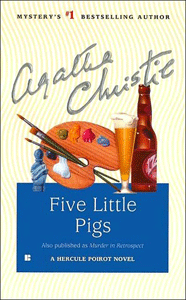The 1930s was Agatha Christie’s decade for mastering plotting, but in the 1940s she consciously became a better character writer. Even amid other strong entries like “Sad Cypress,” “Sparkling Cyanide” and “The Hollow,” “Five Little Pigs” (1942) is her standout among this batch of character-driven mysteries.
A murder in retrospect
Also published as “Murder in Retrospect” — an accurate but not as cheeky title — “Five Little Pigs” finds Hercule Poirot tackling not just a cold case, but an ice-cold one. (Also keep in mind the ice-cold beer, as a clue.) Sixteen years have passed, and Caroline Crale – convicted of murdering her husband, Amyas – long since died in prison.
But their daughter, Carla, learns in a letter opened on her 21st birthday that Caroline claims to have been innocent. For peace of mind, she asks Poirot to look into it.

“Five Little Pigs” (1942)
Also published as: “Murder in Retrospect”
Author: Agatha Christie
Genres: Mystery, romance, family drama
Series: Hercule Poirot No. 22
Setting: Devon, U.K., 1942
The ole softie, who is also likely bothered by a record that needs to be set straight, deigns to investigate for young Carla. This is the overarching instance of Poirot’s warmth and understanding toward the human condition.
I don’t mean “Five Little Pigs” features five warm characters, though. They are all suspects for good psychological reasons, in addition to being on the scene of the crime at the Crale’s wooded riverside estate.
But nor are they five piggish people. Christie’s writing is great because these are five humans who care for other humans; jealousy might make them dangerous. The author crafts a fateful day wherein the events say something about their natures – and those of the sixth and seventh players, who are since deceased.
Well-drawn people
Amyas is obsessed with his artwork and temporarily obsessed with the subject of his painting, beautiful 20-year-old Elsa. Elsa is a selfish young person who possibly leans toward the sociopathy of the girls in the movie “Thoroughbreds.”
Caroline, in her 30s and beautiful in a refined way, is loyal to her husband despite his indiscretions. But she could also be casually cruel in spurning her own suitors.
Rounding out the titular “five” with Elsa are: Phil, the best friend of Amyas who plays the stock markets; Meredith, Phil’s milquetoast brother whose hobby is poisons; Angela, the teenage sister whom Caroline dotes on after accidentally scarring her face when they were children; and Miss Williams, the straight-shooting governess of Angela.
Williams is the one closest to Poirot’s organized heart — although the aging governess wouldn’t feel the same way, as she openly hates all men. But our sleuth has sympathy for the other players — particularly, of course, the young women (or those who were young 16 years ago).
All the characters have core traits – but also the potential to stray beyond those traits. That “Five Little Pigs” goes to this extra layer is what makes it elite.
Straight from the suspects’ pens
There’s also the intensely readable structure. Even though Christie uses longer-than-usual chapters (usually the sign of a novel to be savored, rather than blasted through), “Five Little Pigs” is 185 pages of page-turning goodness.
Poirot gets each of the five survivors to write a narrative of the fateful day, and we get to read them. Christie writes in five distinct personalities.
Meanwhile, “Five Little Pigs’ ” plot should not be discounted. I mention it lower in my review because this is old hat for Christie by 1942, after proving her mettle in the Thirties. I didn’t guess whodunit, but I did guess the reason for the action that supposedly confirmed Caroline’s guilt (but which in fact had a different explanation).
Reading the five narratives, I soaked up the personalities and clues (having been trained by reading enough Christies by now) in equal measure. “Five Little Pigs” could be enjoyed either as a tragic character drama or as a layered (but solvable) mystery puzzle.
But it’s a masterpiece because it can be enjoyed as both simultaneously.
Sleuthing Sunday reviews an Agatha Christie book or adaptation. Click here to visit our Agatha Christie Zone.


